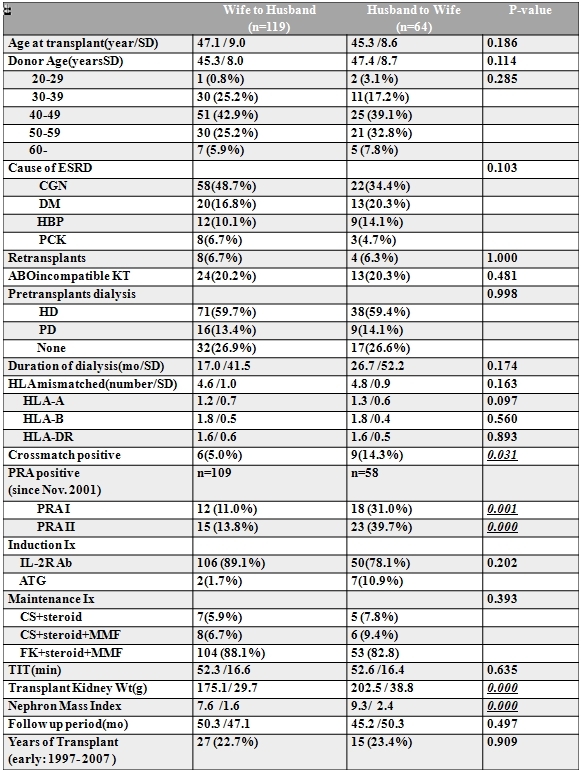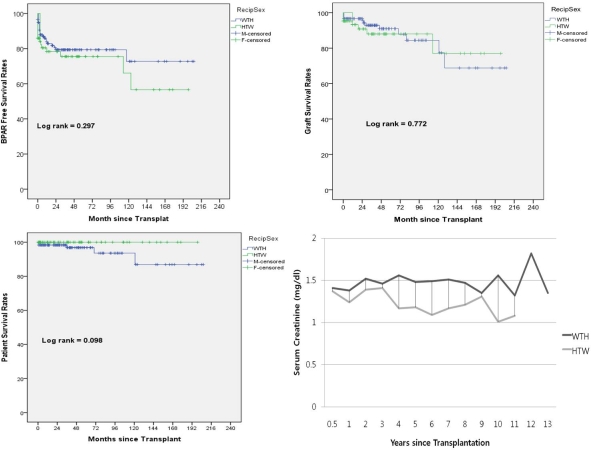Comparison of Clinical Outcomes Between in the Spousal Donor Kidney Tranplants: Wife-to-Husband Versus Husband-to-Wife
K. Jun,1 H. Kim,1 M. Kim,1 K. Park,2 S. Ahn,1 J. Hwang,1 S. Kim,1 S. Park,1 S. Kim,1 J. Kim,1 I. Moon.1
1Vascular and Transplant Surgery, The Catholic University of Korea, Seoul, Korea
2Vascular Surgery, Inha University, Incheon, Korea.
Meeting: 2015 American Transplant Congress
Abstract number: C166
Keywords: Donors, Graft survival, Kidney transplantation, Nephron mass, unrelated
Session Information
Session Name: Poster Session C: Living Donor Issues 2
Session Type: Poster Session
Date: Monday, May 4, 2015
Session Time: 5:30pm-6:30pm
 Presentation Time: 5:30pm-6:30pm
Presentation Time: 5:30pm-6:30pm
Location: Exhibit Hall E
Backgrounds:There is few clinical outcome data between the wife-to-husband recipients(WTHr) and husband-to-wife recipients(HTWr) kidney transplantation. This study was conducted to compare the clinical outcomes between the WTHr and HTWr. Materials and Methods: This is a retrospective single center study from January 1997 to October 2014. 183 spousal donor kidney transplantations were performed in our institute(119-WTHr vs. 64-HTWr). The clinical characteristic and biopsy-proven acute rejection(BPAR) free survival rates, graft survival rates, and patiens survival rates were analyzed. Results: The HTWr demonstrated higher crossmatch positivity, and positive panel-ractive antibodies than in WTHr significantly(fig.1). The nephron mass index(NMI) was higher in HTWr than WTHr, significantly( 7.6 vs. 9.3, p<.001), and mean serum creatinine level was lower in HTWr at all time points. The 15-years BPAR free survival rates were worse in HTWr(56,6%) than WTHr(72.7%) which was not significant(p=.297). And 15-years graft survival rates for WTHr were 68.8% and HTWr were 77.0%(p=.772), and patient survivial were similar in both group(93.6% vs. 100%, p=.098)(fig.2).Conclusion: In this study the BPAR free survival rates showed worse outcome in HTWr, even though it was statistically insignificant, and immunogic factors(crossmatch-positive and PRA-positive) were hostile in HTWr. However graft survivcal rates and the patient survival rates were not significantly different in both groups. One possible explanation for these results, is the positive effect of NMI on graft survial, as NMI checked higher in HTWr significantly, and this factor offset the negative factors mentioned above.

To cite this abstract in AMA style:
Jun K, Kim H, Kim M, Park K, Ahn S, Hwang J, Kim S, Park S, Kim S, Kim J, Moon I. Comparison of Clinical Outcomes Between in the Spousal Donor Kidney Tranplants: Wife-to-Husband Versus Husband-to-Wife [abstract]. Am J Transplant. 2015; 15 (suppl 3). https://atcmeetingabstracts.com/abstract/comparison-of-clinical-outcomes-between-in-the-spousal-donor-kidney-tranplants-wife-to-husband-versus-husband-to-wife/. Accessed December 12, 2025.« Back to 2015 American Transplant Congress
